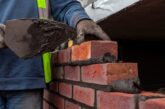
AeroBarrierUK talks airtightness and making homes more energy efficient and sustainable.
As the UK works towards net zero targets, how can housebuilders make their newbuilds more energy efficient and sustainable?
England and Wales both have a median energy efficiency rating of band D, according to the Office for National Statistics. But the right investment can have a significant impact, with taking a home from a D rating to a B saving the average resident around £500 per year.
Traditional methods
Traditionally, caulking and tape have been used to seal gaps in homes. This time-consuming and costly process can be open to human error, as installers have to trust that they have found and covered every gap. Even with the greatest attention to detail this is unlikely, as some gaps will be invisible to the naked eye.
Installers only know how effective their work is once the home is tested, which can be after the project has finished when options are limited to improve airtightness further.
![]()
The impact
Air movement occurs in two forms; deliberately controlled ventilation, such as air supplied through a mechanical ventilation system, and infiltration, which is unintentional air movement through cracks and gaps in the building fabric. Cold, damp, condensation and poor air quality can be caused by air leakage. This has a significant impact on the quality of living for residents and the maintenance costs to upkeep the house.
One of the most common misconceptions about creating an airtight home is that it needs to breathe. One thing is certain, if a building is ‘breathing’ through its envelope, it doesn’t mean clean air is finding its way into and out of the structure – in fact, exactly the opposite is happening. Walls contain all sorts of things, from dust to mites to fibreglass. When you add in the issues of external pollution from roads, any local industry, and penetrating water, the issues quickly mount up.
Damp conditions, caused by a lack of controlled ventilation, can have tragic consequences, as illustrated by the death of two-year-old Awaab Ishack, who suffered a cardiac arrest following a respiratory illness caused by mould in a Rochdale flat in 2020. His death highlighted the need for actively ventilated and accurately designed airtight homes, especially for the more vulnerable people in our society.
Modern building should consider bringing fresh air into the building as a higher priority – by reducing infiltration and improving ventilation, many of these concerns can either be reduced or entirely removed.
![]()
Guaranteeing airtightness
Fortunately, since June 2022, every new dwelling in England and Wales has required an airtightness test to meet Building Regulations. Measuring the effectiveness of airtightness provides a benchmark and allows an accurate understanding of return on investment. Accurate data gives house builders and their customers the peace of mind that the airtightness solutions deliver on their intended promise and improve the living conditions of residents.
Businesses can go one step further and test air leakage as the airtightness solution is being applied to the property. Widely used across tens of thousands of homes in the US, UAE and Canada, AeroBarrier has now been launched in Britain. Homes are pressurised before a sealant mist is distributed. The pressure guides the sealant to all visible and invisible gaps where it solidifies to create a seal and improve air tightness. An operator with a laptop monitors the level of air tightness seal required by the builder, architect or contractor so they can stop the process as soon as the desired level is achieved. Construction can resume normally half an hour after the process is complete with little or no impact on standard schedules.
Learn more about AeroBarrierUK by clicking here.







